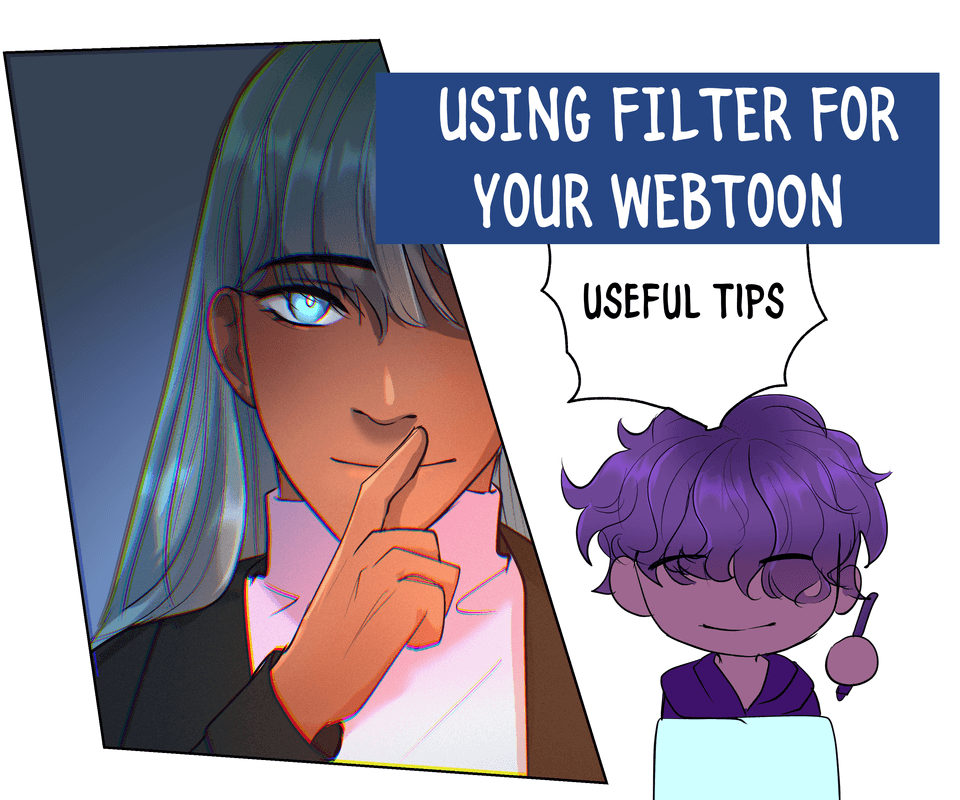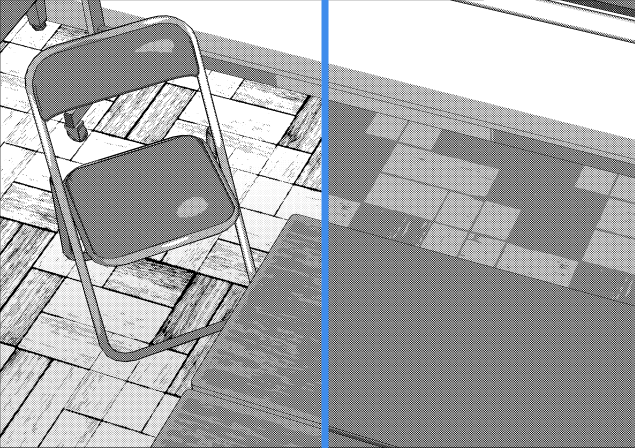Drawing Hair Tips
Intro & Video
Well hello there, this is Tamil. Today I wanted to talk about improving hair artwork. I tried to cover many different things, so it might be a lot of information. Let's get started.
Preparation
Drawing hair is hard, so keep the face very simple to practice more hair. We will need to draw a lot of heads so the hair can sit on top of it. You can even use the 3D models of heads from clip studio paint materials to cut time.
Simple break down for where hair usually starts and ends. Each person is different, but this might help to start out.
Mustache and beard will have a lot more transition compared to the top of the head. Behind the ear, there is no hair touching it. In most cases, you cannot see it anyway because it will be covered.
So how does the hair grow on the head?
Usually, it is easy to find the hair split somewhere in the middle. It helps to find the middle of the face and see which way the head is facing. From the back, it starts to go straight down.
Hair Whorl is also a good landmark to find. It's where most of the hair meets. Some people have it clockwise, some opposite. It is also not always in the center and shifted to the left or to the right.
How to draw Hair
Drawing or sketching hair in a way is more complicated than painting it. The drawing shows all edges, and hair is all about small details and edges. It is easy to get carried away with small strands, but always look for big big shapes.
Start with a general shape. The outline of the head and hair.
Add more details to define big hair strands.
I used a simple marker brush to show the hair flow. This is great for sketching and practicing hair direction.
This is getting a little bit into painting, but you can add more shading and small highlights to define the shape better.
Repeat the process. It takes a lot of time to understand hair:
Start with a simple head shape
Simple face
Start with hair line (optional)
Define big hair shapes
Add shade and highlight ( more about this later )
There is also a technique for no shading. Just follow the flow of the hair and try to think about it as big medium small.
You do not need to connect hair either. Not everything needs to be clean and connected with hair. It might become stiff and less organic.
Where hair meets the most, add more lines to show shade and dark parts. Also keep in min the three stroke technique. Here is a simplified exmaple.
Find big chunks and follow the flow. If you are starting out I would recommend using a bigger brush too. Make it thinner as it goes into the light. Make it thicker as it goes into shadow. This will help to bring depth to the hair. ( look at the previous portrait to see where I put more lines )
Types of Hair
There are a lot of different types of hair. It's had to name all of them because even using hair gel will change the nature of how the hair looks. ( write in the comment if I forgot any! ).
I just used the same head base to show differences in character when changing the haircut.
Straight hair is fun! Pay close attention to highlights and color. It will be the key because the form is hard to capture with thin straight hair.
Wavy and Curly are close together. Really fun to shapes and curly is one of the hardest to do. Maybe put it off for later if you are not sure how to approach it. Think of simplification a lot.
Dreads are also great to see hair flow. It is thick and has a tube shape. Very easy to find the volume and does not require a lot of highlights.
Anime hair is a separate breed. The key is a good line and string shading. I will get into it a bit later. A lot of triangles and simple curves. Sometimes it looks flatter than other hair because of the style, so think of shading as showing form.
Thick hair is straight with extra steps ? It is not a separate category, but definitely nice to mention. Most of it comes with extra air between the hair strands, so it feels like a cloud. Really fun to paint.
Render small hair piece
Before jumping into it right away, I recommend finding small parts of hair on a reference to practice drawing. No face and no skull. Just something simple.
This is just practice without any reference. Really helpful once you get going. Keep it small.
The process is similar to everything else I do:
Sketch
Line
Block out
3 values
Airbrush with Overlay layer ( white and black mostly )
Go with a watercolor brush to blend it.
Add more contrast.
( add a sliding human for fun )
You can watch the process in my youtube video. Most of what I am showing here is timelapsed!
Anime render
This one is tricky. There are so many good examples and different styles, it is hard to say how to do it. The main suggestions are:
Confident line
Colorful and bright highlight
Blend under line if needed
If I had to do it again, I would definitely do a thinner line. I also filled it with very dark red, which helped it look more interesting. I think using a hard brush instead of trying to blend it also helps.
Using a lot of overlay and gradients helped. In this case, I tried using soft light too. Simplify and think about animation too. A lot of style for anime comes from hand-drawn animation and manga, where black and white is very strong. Focus on line and 2 cell shading if you want to start simple.
Comic style hair
Comic style hair usually has more detail and thick dark shadows. The gentle thin line is not always a good choice here. A confident line will get you very far. Sometimes there is even some cross-hatching and pencil shading if you doing traditional.
Sketching general form. Adding main dark parts. Usually behind and where hair grows.
Think of 3D form and look at modern comics. Always reference and see how they do it. It helped me a lot when I was learning. Focus on dark parts and add more shading to them than usual. A lot of comic stuff comes from heavy inking.
How to Draw Braids
Braids are a very common thing to have for hairstyles, so it is good to start practicing them. It might be very intimidating, but if you break it down, it is not that bad,
If you draw a tube, you can just draw the missing parts inside too to fill in the blank. Think of it as long spheres connecting to each other.
But you can always start with less 3D and focus on how it looks simplified. Usually, the light hits the middle and everything else gets darker as it goes inside. A pretty simple way to shade it.
The pattern is easy to remember. You can just draw a cube or a circle and half of the side will be where the other cube or circle starts. Just think about the zig-zag and half and half each time and you will do just fine.
Common hair styles
There are so many different hairstyles. Even looking at a decade, like 80s vs 90s. It is very different. I just decided to draw some easy ones that you can find among people on the street and something that could be a good practice. Not all hairstyles are easy to draw, so pick your reference based on your style and skill.
For guys, hair is usually shorter and denser. Shorter hair means fewer hair clumps. A bowl cut and hair gel are very popular. Especially for younger guys xD. It is harder to find big shapes with it, so focus on texture and tone. There are always exceptions, so observe haircuts next time you go to a coffee shop or something. See what you see more and how it looks.
Girls have a lot more variations in terms of length and style. I am no hair style expert, so it is hard to say things for sure.
Generally, it falls into categories by length: long, medium, short. The short hairstyle is commonly called the pixie style. That term helped me with finding good images.
Medium size is usually called Bob Cut. Pretty popular and my favorite to see on any female character. It just has that look that brings out the jaw and the neck very nicely. Easy to draw and it ends mid-air, so you do not need to think about the collision.
Buns are really cool shapes. Essentially, it is a sphere, so it is easy to find it and apply light to it. Follow the hair flow and you will do great.
Thumbnail Exercise
I did some great learning by creating some small thumbnails on landscapes! I think using the same method but for hair might be useful to learn about the color and values. Do not worry about the structure or details. Just focus on big shapes.
Get a relatively big brush and make big strokes. Try to simplify what you see and paint small. This really helps with color sense and not getting too much into details. I used a very small size for it. My hand is a bit sore from that too xD
Full Render Step by Step
This is a closing section in which I will try to draw a step-by-step hair to practice. Find yourself a reference and try to do the same. Lots of practice is the key to success.
Usually starting with a rough sketch helps. A bigger brush or not precise drawing is going to give it more gesture.
Refine the sketch. Add thick lines for shadows and define more shapes. Simplify and lower the opacity for the bottom layer.
Fill in the base layer and use the clipping mask for later. I have covered it in my tutorials and other people have great sources on it, so I feel like it would be best to keep this tutorial focused on the hair.
Air brush would help be define big shapes. Just think of big spheres and hairs. I barely add any details.
Added more highlights and clean up. This is the part where I will go with a brush on top and paint over lines too. Just merge everything together.
Add more small strands coming out of the hair. Use rim light to define more shapes. I used curves to fix some color and lower the green on the face. Adding background color also helped.
Bonus portrait that I think was also fun to paint. This time a male study!
Sketching out big shapes and trying to follow the hair flow.
Lay down big shadow areas and some face details.
Merge everything and start adding details to the hair. Watch out for colors. It is really a crucial stage to find the right reflections. It was really rough on me this time if I am being honest. Blonde hair has very subtle reflections.
Add background and rim light just like last time. Really focusing on the hair and how it flows. This time I pushed the darks and focused on harder edges.
Outro
Thanks for reading. You can always see my video for more time lapse and my explanation. I really hope you learned something and let me know if there is anything that I missed. Happy painting!
My socials



















Comment